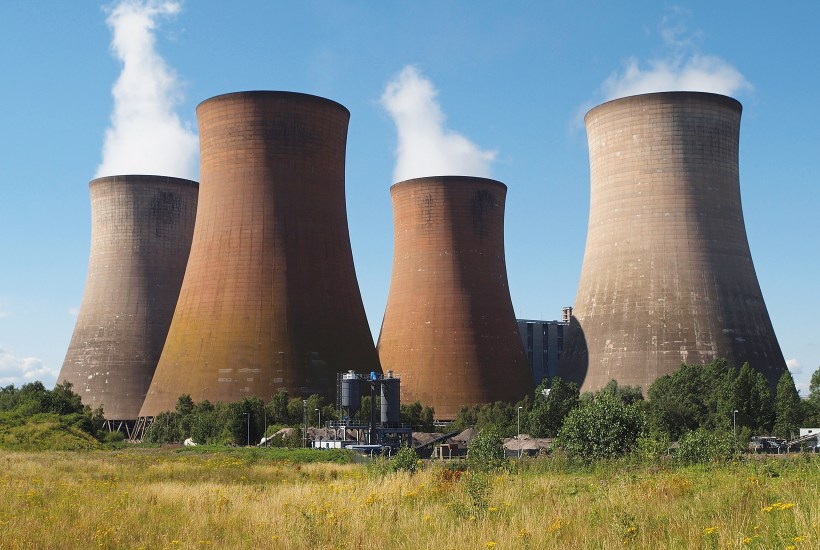One afternoon earlier this summer we drove through Rugeley in Staffordshire. There, looming above the A51, were the cooling towers of the power station: a pinkish red, resembling terracotta, with curving convex sides, like modernist vases on a pharaonic scale. At 385 feet high, they were a little taller than the dome of St Paul’s Cathedral.
We remarked on how surprisingly good they looked as we passed them on 4 June, en route to a spot in the Staffordshire countryside where we were going to stay. On 6 June there was a distant rumble like thunder but we thought little of it. However, that evening when we glanced at the horizon there was a gap where the towers had been.
The mighty cooling towers of mid-20th century power stations were monumental features of the British landscape for half a century. Huge thought went into their siting by landscape architects such as Brenda Colvin and Sylvia Crowe (author of The Landscape of Power). Now they are disappearing fast. Didcot A and B are both gone. Four of the eight at Eggborough were blown up the other day. Of course, when they were being built, they were widely loathed as gigantic eyesores. Many people are probably glad to see them go. Nonetheless, others will miss them, and as a general rule it’s only when things are gone or about to go that we discover that we value them.
Those towers raise in an acute form the dilemmas of preservation, which are, in a nutshell: what to keep, how we should do it and why we should bother. David Hockney has observed that in general works of art and architecture survive for one of two reasons: either because they are made of some material so robust it is hard to destroy or because somebody loves them.
Few buildings come into the first category. Perhaps prehistoric standing stones might qualify, though even those often turn out to have been dug up and re-erected in their original positions or saved from farmers who had hopes of dynamiting them to tidy up a field. The current debate about the tunnel at Stonehenge shows that even saving that world-famous and extremely solid structure, together with its surrounding setting, from rumbling traffic and armies of visitors is far from straightforward.
Most human artefacts only survive because other human beings decide to keep them going. What’s more, it’s often the threat that they are about to vanish that sparks a desire to protect them from extinction. Britain, for example, is crammed with medieval churches, houses and castles. But the fact that these were restored, reroofed and generally shored up was a direct reaction to the fact that in the early 19th century most of these buildings were in the condition John Piper described as ‘pleasing decay’.
That is, they were in a state of attractively picturesque crumbliness, as can be seen in the works of painters such as Turner and Cotman. If these ancient walls had been left alone for another half-century or so, most would have collapsed into a heap of stones. Instead, the Victorians decided to look after them with such enthusiastic vigour that frequently medieval churches ended up so completely rebuilt as to be in effect 19th-century buildings.
That, however, was only an extreme case of a common dilemma. It’s difficult to preserve anything without changing it (what we will do with all those marvellous churches if belief in Christianity withers away will present us with another quandary).
Often, salvation occurs only after a period of loathing and active destruction. Not everybody was in favour of looking after venerable places of worship. In 1809 the superb 8th-century church at Reculver in Kent (see p31) was demolished with gunpowder, the vicar having cast the deciding vote to do so apparently because his mother objected to visitors coming to admire it as if it were a ‘poppet show’.
A week ago I went to look at the 18th-century church at Shobdon near Leominster, an example of Strawberry Hill ‘gothick’, and one of the few buildings in Britain which might qualify for the term rococo. To clear the site to build it, the 2nd Viscount Bateman demolished the existing Norman church which was clearly a masterpiece of Romanesque sculpture. He saved the chancel arch and a couple of richly carved doorways and put them up as a park ornament. They are still there, and though horribly eroded by the rain and wind, just enough is left to show what has been lost.
Shobdon poses unanswerable questions. Would we rather have the early medieval version, or the fantastic, 18th-century wedding cake successor? The friend I visited it with said that it was a shame that Viscount Bateman hadn’t kept the old one and built his new one by its side. But of course Georgian aristocrats didn’t think like that. Like all the rest of us, they were confident that their tastes were insuperably correct and anyone who didn’t share them was wrong.
Thus, almost everyone in mid-20th century Britain took the view that everything Victorian was hideous. Reputedly there was once a club for members of Keble College, Oxford, to qualify for which one had to produce a detached part of the fabric — a brick, say, or a tile. The idea was that in this way the whole parti-colour, neo-gothic magnum opus (or for those who disliked it, monstrosity) designed by William Butterfield might be slowly dismantled.
Actually, of course, a large number of grand 19th-century edifices were knocked down before enough people decided that eccentrics such as John Betjeman were correct and we ought to keep them when we could. So we hung onto St Pancras and King’s Cross, but lost Euston and New Street, Birmingham. Of course, with preservation there’s always a trade-off.
If you take the venerable Venetian view that everything should remain ‘com’era, dov’era’ — as it was, where it was — you both gain and lose. There are perhaps few cities in the world that look so much today the way that they did in 1800 as Venice does. On the other hand, quite a few opportunities were missed for fine 20th-century Venetian buildings by Le Corbusier and Frank Lloyd Wright among others. Mind you, it is true that very few would argue that we got a good bargain when the old classical Euston was replaced by the present indescribably banal terminus in the 1960s.
The chances of preserving even a few of those cooling towers are probably slim. To retain something we will need to find some use for it, even if it is to be a museum or monument. In a world without coal-fired power stations it is hard to imagine a role for their cooling towers. Perhaps some contemporary artist might take one on (Anselm Kiefer considered transforming a decommissioned nuclear plant on the Rhine into a vast work of art). But the odds are not favourable. Probably the towers are as doomed as the woolly mammoth. But when they are gone, I’ll miss them. And I don’t think I’ll be alone.
Got something to add? Join the discussion and comment below.
Get 10 issues for just $10
Subscribe to The Spectator Australia today for the next 10 magazine issues, plus full online access, for just $10.
You might disagree with half of it, but you’ll enjoy reading all of it. Try your first month for free, then just $2 a week for the remainder of your first year.














Comments
Don't miss out
Join the conversation with other Spectator Australia readers. Subscribe to leave a comment.
SUBSCRIBEAlready a subscriber? Log in